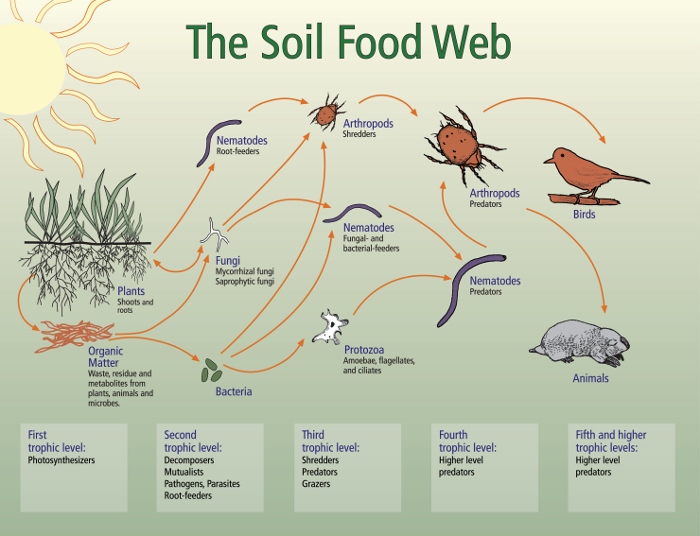Soil ecologists tell us that there is an entire soil food web to be found under our feet, including bacteria, fungi, protozoa, nematodes, micro-arthropods, and the larger plants and animals. The soil food web is the community of organisms living all or part of their lives in the soil. It is called a web in order to focus on the interaction between the different components.
Our soil health is dependent on the correct balance in the components of this web.
These many microorganisms continuously perform varied functions that help maintain healthy ecosystems, including decomposition of organic matter, nutrient cycling, retention of nutrients, bioturbation (the movement of gases and water into and through the soil), disease suppression and toxin decomposition.
Each group in this web contributes to the well-being of plants that are growing in the soil, although a few of them also eat plants and roots.
The Different Organisms
Bacteria are minuscule one-celled organisms that can only be seen with a powerful light or electron microscope. In soil they help with the carbon cycle and nitrogen fixation, they help bind soil particles into small aggregates, suppress root-disease and filter and degrade a large variety of human-made pollutants.
Fungi provide many of the same services for plants as bacteria, but they are much more varied in their composition. They may be single-celled or they may have billions of cells (such as a mushroom). Fungi generally eat by excreting digestive enzymes that dissolve their food, so they are particularly useful in decomposition. They also harvest minerals, such as phosphorus, from rocks that are virtually inaccessible to other organisms until released by the fungi. Fungi release nutrients that plants then absorb.
Leaves are coated with innocuous or beneficial bacteria, and plant roots are completely encrusted with bacteria and symbiotic fungi.
Bacteria and fungi are consumed by protozoa, which are minute single-celled animals such as amoebas, paramecia, rotifers and flagellates. Apart from keeping bacteria in balance, they release nitrogen and other nutrients in their waste, which are absorbed by plant roots. Protozoa stimulate the rate of decomposition and they are in turn consumed by nematodes and micro-arthropods.
Nematodes are tiny roundworms that are common in soils everywhere. Those few species responsible for plant diseases have received a lot of attention, but far less is known about the majority of the nematode community that plays beneficial roles in soil. Nematodes feed on decaying plant material, along with organisms ~ bacteria and fungi ~ that assist in the decomposition of organic matter. Predatory nematodes eat all types of nematodes and protozoa. Like protozoa, nematodes are important in mineralizing, or releasing, nutrients in plant-available forms. When nematodes eat bacteria or fungi, ammonium (NH4+) is released because bacteria and fungi contain much more nitrogen than the nematodes require. Nematodes help distribute bacteria and fungi through the soil and along roots by carrying live and dormant microbes on their surfaces and in their digestive systems. Nematodes are used to gauge the health of soil.
Nematodes provide a source of food for soil arthropods, which are invertebrates with segmented bodies and jointed legs. They include mites, spiders, and pseudo-scorpions, centipedes, millipedes, and symphylans, crustaceans, springtails and insects. Arthropods have important role in maintaining soil fertility, they aerate the soil, shred organic matter into small pieces and assist other soil organisms in the decomposition process. Arthropods also stimulate mineralization of nutrients in soil.
Earthworms are another important component of soil fauna communities, influencing soil structure by feeding, casting, and burrowing. These activities can either improve or reduce the stability of soil aggregates, as well as aeration and the drainage ability of the soil.
Burrowing animals such as moles, as well as birds also play roles in maintaining the balance in the soil food web.
Co-operation and Competition
All of these components of soil work together to maintain soil fertility and productivity. They are dependent on each other, while they also compete with each other.
Soil practices in cultivated ecosystems significantly alter arthropod community which in turn has significant effect on soil productivity.
In order to support soil organisms we need to limit soil disturbance and tillage; restore overly compacted soils by digging in organic matter such as manure and compost to allow air and water movement; cover soil with plants or mulch; regularly apply layers of compost or organic mulch to the top of the soil and avoid pesticides that may harm soil biota.
We should avoid monoculture, where only one crop is planted in a field, and rather practice companion planting, intercropping and cover cropping.
This is part four in a five-part series on Soil Health. For more, click here.
Main Image: National Resources Conservation Service, USDA


Please show more about the soil food web and no till practices, I’d love to learn more!